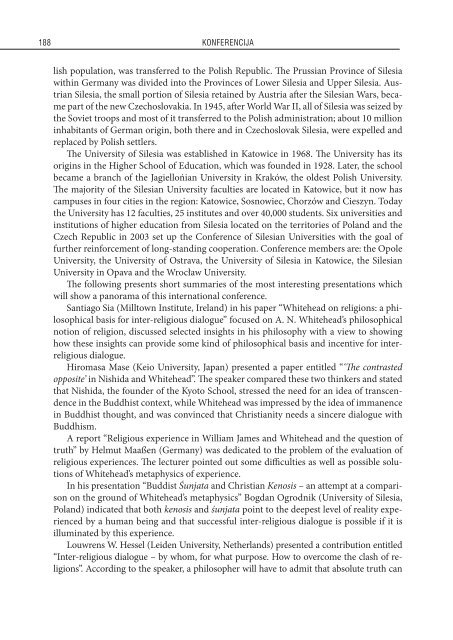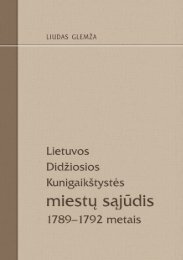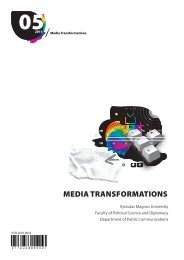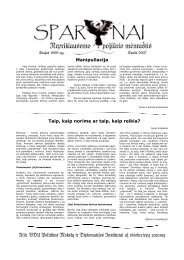Soter Nr. 26 - Vytauto Didžiojo universitetas
Soter Nr. 26 - Vytauto Didžiojo universitetas
Soter Nr. 26 - Vytauto Didžiojo universitetas
You also want an ePaper? Increase the reach of your titles
YUMPU automatically turns print PDFs into web optimized ePapers that Google loves.
188<br />
KONFERENCIJA<br />
lish population, was transferred to the Polish Republic. The Prussian Province of Silesia<br />
within Germany was divided into the Provinces of Lower Silesia and Upper Silesia. Austrian<br />
Silesia, the small portion of Silesia retained by Austria after the Silesian Wars, became<br />
part of the new Czechoslovakia. In 1945, after World War II, all of Silesia was seized by<br />
the Soviet troops and most of it transferred to the Polish administration; about 10 million<br />
inhabitants of German origin, both there and in Czechoslovak Silesia, were expelled and<br />
replaced by Polish settlers.<br />
The University of Silesia was established in Katowice in 1968. The University has its<br />
origins in the Higher School of Education, which was founded in 1928. Later, the school<br />
became a branch of the Jagiellońian University in Kraków, the oldest Polish University.<br />
The majority of the Silesian University faculties are located in Katowice, but it now has<br />
campuses in four cities in the region: Katowice, Sosnowiec, Chorzów and Cieszyn. Today<br />
the University has 12 faculties, 25 institutes and over 40,000 students. Six universities and<br />
institutions of higher education from Silesia located on the territories of Poland and the<br />
Czech Republic in 2003 set up the Conference of Silesian Universities with the goal of<br />
further reinforcement of long-standing cooperation. Conference members are: the Opole<br />
University, the University of Ostrava, the University of Silesia in Katowice, the Silesian<br />
University in Opava and the Wrocław University.<br />
The following presents short summaries of the most interesting presentations which<br />
will show a panorama of this international conference.<br />
Santiago Sia (Milltown Institute, Ireland) in his paper “Whitehead on religions: a philosophical<br />
basis for inter-religious dialogue” focused on A. N. Whitehead’s philosophical<br />
notion of religion, discussed selected insights in his philosophy with a view to showing<br />
how these insights can provide some kind of philosophical basis and incentive for interreligious<br />
dialogue.<br />
Hiromasa Mase (Keio University, Japan) presented a paper entitled “‘The contrasted<br />
opposite’ in Nishida and Whitehead”. The speaker compared these two thinkers and stated<br />
that Nishida, the founder of the Kyoto School, stressed the need for an idea of transcendence<br />
in the Buddhist context, while Whitehead was impressed by the idea of immanence<br />
in Buddhist thought, and was convinced that Christianity needs a sincere dialogue with<br />
Buddhism.<br />
A report “Religious experience in William James and Whitehead and the question of<br />
truth” by Helmut Maaßen (Germany) was dedicated to the problem of the evaluation of<br />
religious experiences. The lecturer pointed out some difficulties as well as possible solutions<br />
of Whitehead’s metaphysics of experience.<br />
In his presentation “Buddist Śunjata and Christian Kenosis – an attempt at a comparison<br />
on the ground of Whitehead’s metaphysics” Bogdan Ogrodnik (University of Silesia,<br />
Poland) indicated that both kenosis and śunjata point to the deepest level of reality experienced<br />
by a human being and that successful inter-religious dialogue is possible if it is<br />
illuminated by this experience.<br />
Louwrens W. Hessel (Leiden University, Netherlands) presented a contribution entitled<br />
“Inter-religious dialogue – by whom, for what purpose. How to overcome the clash of religions”.<br />
According to the speaker, a philosopher will have to admit that absolute truth can





